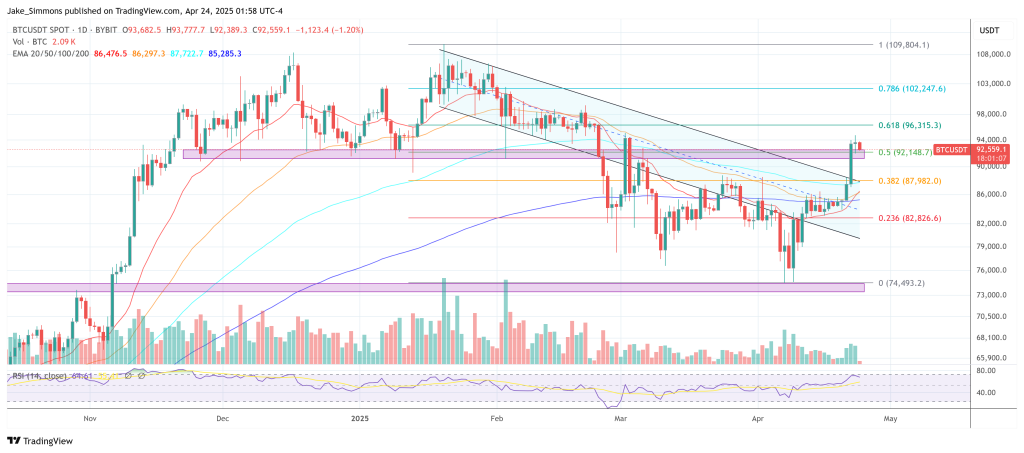Bitcoin price
Don't Fall for the Bitcoin Crash – It's Just a Breather
Published
4 months agoon
By
admin


If you’ve been watching bitcoin, you probably noticed the pullback yesterday. It dropped from $108,000 to $99,000 after the FOMC meeting, where the Fed cut rates, and Jerome Powell, the Fed Chair, when asked about the Strategic Bitcoin Reserve, said: “We’re not allowed to own bitcoin and not looking for a law change.”. The market, as usual, overreacted by dumping bitcoin. But let me tell you: This dip? It’s nothing to worry about.
First of all, Jerome Powell’s comments shouldn’t have surprised anyone. The Fed doesn’t control Bitcoin policy—Congress does. David Bailey, CEO of BTC Inc., even pointed this out, saying the Strategic Bitcoin Reserve would have “nothing to do with the Fed. It’d be housed at the Treasury.” So, Powell’s comments are irrelevant when it comes to a Strategic Bitcoin Reserve for the USA. The market just needed an excuse to cool off after its recent explosive run.
And honestly, dips like this are healthy—especially in a bull market. This isn’t my first rodeo. I’ve been through three bitcoin bull markets since I jumped in back in 2016, and trust me, these pullbacks are totally normal, and they’re part of the process. They shake out weak hands, consolidate support, and set the stage for even bigger moves. From my experience, we’ve only just entered this bull market, and the real fireworks aren’t coming until 2025.
Think about it: Trump hasn’t even taken office yet. His administration is likely to push pro-Bitcoin and crypto regulations, and combined with increasing institutional and global adoption the next year could be huge for the space.
So, don’t panic. Don’t let the short-term noise shake you out of the long-term game. Instead, use these pullbacks to your advantage. I’d personally be buying the dips, stacking sats, and preparing for what’s ahead.
This article is a Take. Opinions expressed are entirely the author’s and do not necessarily reflect those of BTC Inc or Bitcoin Magazine.
Source link
You may like


Tariff Carnage Starting to Fulfill BTC’s ‘Store of Value’ Promise


The cost of innovation — Regulations are Web3’s greatest asset


Best Crypto to Buy as Derivatives Exchange CME Set to Launch XRP Futures


Metaplanet Buys Additional ¥1.92 Billion Worth Of Bitcoin


Here Are Four Signs the Stock Market Has Bottomed, According to Fundstrat’s Tom Lee


Bitcoin dips below $94,000 as ETFs record $3b weekly inflow
Bitcoin
Bitcoin Continues To Flow Out Of Major Exchanges — Supply Squeeze Soon?
Published
11 hours agoon
April 27, 2025By
admin
Reason to trust

Strict editorial policy that focuses on accuracy, relevance, and impartiality
Created by industry experts and meticulously reviewed
The highest standards in reporting and publishing
Strict editorial policy that focuses on accuracy, relevance, and impartiality
Morbi pretium leo et nisl aliquam mollis. Quisque arcu lorem, ultricies quis pellentesque nec, ullamcorper eu odio.
It was quite the coincidence that the cryptocurrency market jolted back to life after Easter Sunday, with Bitcoin leading the way with more than a double-digit gain. While the price of BTC continues to hold above the critical $94,000 level, the premier cryptocurrency seems to be losing some momentum.
Unsurprisingly, investors appear to be increasingly confident in the promise of this recent rally, as significant amounts of BTC continue to make their way off major centralized exchanges over the past few days. Here’s how much investors have moved in the past few days.
Over 35,000 BTC Move Out Of Coinbase And Binance
In a Quicktake post on the CryptoQuant platform, crypto analyst João Wedson revealed that Binance, the world’s largest cryptocurrency exchange by trading volume, has seen increased activity over the past few days. The exchange netflow data shows that huge amounts of Bitcoin have been withdrawn from the platform in recent days.
Related Reading
According to CryptoQuant data, a total of 27,750 BTC (worth $2.63 billion at current price) was moved out of Binance on Friday, April 25. This latest round of withdrawals represents the third-largest net outflow in the centralized exchange’s history.
The movement of significant crypto amounts from exchanges, which offer services like selling to non-custodial wallets, suggests a potential shift in investor sentiment and strategy. Large exchange outflows often signal increased confidence of holders in the long-term potential of an asset.
Wedson noted that the recent outflows do not guarantee a price rally for Bitcoin, but they do signal strong institutional activity, which is often a precursor for major volatility. Citing China’s crypto ban in 2021, the crypto analyst highlighted how massive exchange outflows didn’t prevent the dump.

At the same time, Wedson mentioned that the continuous Bitcoin outflows over several days, like during the FTX collapse, preceded a price bottom and the eventual market recovery. Ultimately, the online pundit hinted at paying close attention to the overall trend of the exchange netflow rather than a single-day activity.
Similarly, more than 7,000 BTC (worth approximately $66.5 million) have made their way out of the Coinbase exchange. According to the CryptoQuant analyst Amr Taha, this negative exchange netflow could be an indicator of increased institutional activity, as Coinbase is known as the primary crypto vendor for US-based institutions.
Taha said:
These large outflows typically suggest accumulation by institutions or large investors, potentially signaling bullish sentiment.
The analyst outlined that if the dwindling exchange reserves correlate with an increased spot demand or ETF inflows, a supply squeeze could be on the horizon, potentially pushing the price to the upside.
Bitcoin Price At A Glance
As of this writing, the price of BTC sits just beneath $95,200, reflecting an almost 2% increase in the past 24 hours.
Related Reading
Featured image from iStock, chart from TradingView
Source link
Bitcoin
Bitcoin Price Recovery At Stake If This Level Doesn’t Hold, Crash Could Erase Gains
Published
3 days agoon
April 24, 2025By
admin
Reason to trust

Strict editorial policy that focuses on accuracy, relevance, and impartiality
Created by industry experts and meticulously reviewed
The highest standards in reporting and publishing
Strict editorial policy that focuses on accuracy, relevance, and impartiality
Morbi pretium leo et nisl aliquam mollis. Quisque arcu lorem, ultricies quis pellentesque nec, ullamcorper eu odio.
Crypto analyst Rekt Capital has revealed that the Bitcoin price recovery could be at stake if it doesn’t hold above a particular level. Failure to hold this support level could cause the leading crypto to crash and erase all gains that it has enjoyed this past week.
Bitcoin Price Needs To Hold Above $93,500 To Avoid Another Crash
In an X post, Rekt Capital indicated that the Bitcoin price needs to hold above $93,500 to avoid another crash. He remarked that the downside deviation is on the cusp of ending, but BTC now needs to stabilize above this support level of $93,500. The analyst added that ideally, the leading crypto needs a weekly close above this level and reclaim it as new support to resynchronize with the former Reaccumulation range.
Related Reading
The Bitcoin price has already rallied above $93,500 this week as the leading crypto decoupled from stocks, with investors viewing it as a safe haven amid the market uncertainty caused by Donald Trump’s tariffs. However, as Rekt Capital suggested, BTC now needs to hold above $93,500 to confirm this breakout and avoid this being another bull trap.

The Bitcoin price is likely to reclaim the $100,000 mark and even reach new highs if it can hold above this crucial support level. Rekt Capital’s accompanying chart showed that BTC could rally to as high as $110,000, marking a new all-time high (ATH) for the leading crypto.
Crypto analyst Ezy Bitcoin also predicted that the Bitcoin price could rally to as high as $166,700. He stated that the Wyckoff Re-accumulation phase is playing out beautifully. The analyst further remarked that the structure points toward continued strength with the spring confirmed and price jumping across the creek. Ezy Bitcoin outlined $131,500, $144,900, and $166,700 as the targets if this bullish momentum holds.
BTC Needs One More Leg On The LTF To Confirm Breakout
In an X post, crypto analyst CrediBULL Crypto stated that the Bitcoin price needs one more leg on the lower timeframes (LTFs) to seal the deal. If that happens, he asserted that dips are for buying until BTC reaches at least $150,000. His accompanying chart showed that the leading crypto could break above $100,000 again on this next leg up.
Related Reading
However, if the Bitcoin price doesn’t record another leg to the upside and instead corrects below $89,000 first, CrediBULL stated that BTC then ends up with a 3-legged corrective structure. He added that it would mean that market participants have to wait longer for the “real” breakout.
At the time of writing, the Bitcoin price is trading at around $92,600, down in the last 24 hours, according to data from CoinMarketCap.
Featured image from Adobe Stock, chart from Tradingview.com
Source link
Arthur Hayes
Déjà Boom—Arthur Hayes Says Bitcoin’s 2022 Rally Setup Is Back
Published
3 days agoon
April 24, 2025By
admin
Reason to trust

Strict editorial policy that focuses on accuracy, relevance, and impartiality
Created by industry experts and meticulously reviewed
The highest standards in reporting and publishing
Strict editorial policy that focuses on accuracy, relevance, and impartiality
Morbi pretium leo et nisl aliquam mollis. Quisque arcu lorem, ultricies quis pellentesque nec, ullamcorper eu odio.
Arthur Hayes, the co-founder of BitMEX who now runs the family-office-style fund Maelstrom, believes the macro cocktail that ignited Bitcoin’s six-fold advance from late 2022 into early 2025 is being mixed again. Speaking on the “Forward Guidance” podcast just minutes after a market-soothing Trump press conference, Hayes said the present environment “feels like November 2022.”
Can Bitcoin Increase Sixfold Again?
In Hayes’s telling, the fulcrum of the next impulse is not the Federal Reserve but the US Treasury. “People forgot about the other side of the equation,” he argued. “Yellen printed two-and-a-half trillion dollars just by switching issuance to bills, and now Scott Bessent is talking about Treasury buybacks—another form of stealth quantitative easing that needs no input from the Fed.” Hayes cited his own arithmetic from the previous episode: between September 2022 and early 2025, Bitcoin rose roughly 6x while the Fed’s balance sheet was ostensibly shrinking, a move he attributes almost entirely to Treasury-engineered liquidity.
Related Reading
That dynamic, he contends, has returned. The Trump administration’s initial “maximalist” tariff schedule, announced in mid-April and aimed at slashing the US current-account deficit, triggered a brief but violent sell-off in bonds and equities before Trump began “concession after concession.” The rapid policy retreat, Hayes said, confirms that “the American financial system is so highly levered it couldn’t take one week” of trade hardball. To him, that single week exposed the political impossibility of fiscal retrenchment and made additional money creation inevitable. “They can call it whatever they want—just don’t call it QE—but it has the same effect: liquidity rises and Bitcoin benefits.”
Hayes’s decoupling thesis rests on arithmetic as much as narrative. If tariffs do trim the current-account gap, the mirror-image financial-account surplus must also fall, reducing foreign demand for US mega cap stocks.
“Mathematically, if Trump is serious, foreigners have to sell stocks. Period,” he said. In that world, Bitcoin’s flows are driven not by equity beta but by a global scramble for neutral stores of value amid escalating currency and trade friction. He expects “US-tech exceptionalism” to fade just as Bitcoin’s structural bid strengthens.
Related Reading
The former BitMEX chief also sees a latent tail-risk in Japan. A stronger yen, encouraged by Washington to help weaken the dollar, could force Japanese investors to unwind enormous USD carry trades, dumping Treasuries and pushing yields toward levels that would “corner the Fed into covert curve control.”
Any volatility spike of that kind, Hayes noted, historically elicits a rapid-fire response from the Federal Reserve—even if it arrives cloaked as a new alphabet facility rather than outright bond-buying. “Every time bond-market volatility spikes, the Fed does something,” he remarked. “It might not be QE in the traditional form, but it leads to the same outcome.”
Throughout the hour-long conversation Hayes returned to November 2022 as the template. Back then, markets were reeling from the aftermath of FTX and bond yields were surging, yet Bitcoin began a relentless grind upward as the Treasury tapped the reverse-repo basin for fresh cash. Today, he sees an echo: “This feels like November 2022,” he told host Felix Jauvin. “Shit’s going up.”
While Hayes stopped short of naming a price target, the implication was clear. In 2022–25 the stealth-liquidity wave took Bitcoin from roughly $16,000 to above $100,000. With Besson’s buyback machinery “ready to go” and political appetite for austerity already exhausted, Hayes says the stage is set for a sequel.
At press time, BTC traded at $92,559.

Featured image created with DALL.E, chart from TradingView.com
Source link

Tariff Carnage Starting to Fulfill BTC’s ‘Store of Value’ Promise

The cost of innovation — Regulations are Web3’s greatest asset

Best Crypto to Buy as Derivatives Exchange CME Set to Launch XRP Futures

Metaplanet Buys Additional ¥1.92 Billion Worth Of Bitcoin

Here Are Four Signs the Stock Market Has Bottomed, According to Fundstrat’s Tom Lee

Bitcoin dips below $94,000 as ETFs record $3b weekly inflow

Bitcoin Post-Halving Price Performance Is the Worst on Record. Why?

Expert Predicts Start Date For Pi Network Price Pump

GameFi Tokens Show Signs of Life After Gala Games, White House Tie-Up

Bitcoin trades at ‘40% discount’ as spot BTC ETF buying soars to $3B in one week

Bitcoin Continues To Flow Out Of Major Exchanges — Supply Squeeze Soon?

BlackRock’s Bitcoin ETF Sees $643 Million Inflows

DePIN Altcoin Outpaces Crypto Market and Skyrockets by Nearly 44% Following High-Profile Exchange Listing

Solaxy, BTC bull token, and Pepeto gaining momentum as leading 2025 presale tokens

Australian Radio Station Used AI DJ For Months Before Being Discovered

Arthur Hayes, Murad’s Prediction For Meme Coins, AI & DeFi Coins For 2025

Expert Sees Bitcoin Dipping To $50K While Bullish Signs Persist

3 Voting Polls Show Why Ripple’s XRP Price Could Hit $10 Soon

Aptos Leverages Chainlink To Enhance Scalability and Data Access

Bitcoin Could Rally to $80,000 on the Eve of US Elections

Crypto’s Big Trump Gamble Is Risky

Sonic Now ‘Golden Standard’ of Layer-2s After Scaling Transactions to 16,000+ per Second, Says Andre Cronje

Institutional Investors Go All In on Crypto as 57% Plan to Boost Allocations as Bull Run Heats Up, Sygnum Survey Reveals

The Future of Bitcoin: Scaling, Institutional Adoption, and Strategic Reserves with Rich Rines

Ripple-SEC Case Ends, But These 3 Rivals Could Jump 500x

Has The Bitcoin Price Already Peaked?

A16z-backed Espresso announces mainnet launch of core product

Xmas Altcoin Rally Insights by BNM Agent I

Blockchain groups challenge new broker reporting rule

I’m Grateful for Trump’s Embrace of Bitcoin
Trending

 24/7 Cryptocurrency News6 months ago
24/7 Cryptocurrency News6 months agoArthur Hayes, Murad’s Prediction For Meme Coins, AI & DeFi Coins For 2025

 Bitcoin3 months ago
Bitcoin3 months agoExpert Sees Bitcoin Dipping To $50K While Bullish Signs Persist

 Ripple Price1 month ago
Ripple Price1 month ago3 Voting Polls Show Why Ripple’s XRP Price Could Hit $10 Soon

 24/7 Cryptocurrency News4 months ago
24/7 Cryptocurrency News4 months agoAptos Leverages Chainlink To Enhance Scalability and Data Access

 Bitcoin6 months ago
Bitcoin6 months agoBitcoin Could Rally to $80,000 on the Eve of US Elections

 Opinion6 months ago
Opinion6 months agoCrypto’s Big Trump Gamble Is Risky

 Altcoins3 months ago
Altcoins3 months agoSonic Now ‘Golden Standard’ of Layer-2s After Scaling Transactions to 16,000+ per Second, Says Andre Cronje

 Bitcoin5 months ago
Bitcoin5 months agoInstitutional Investors Go All In on Crypto as 57% Plan to Boost Allocations as Bull Run Heats Up, Sygnum Survey Reveals


